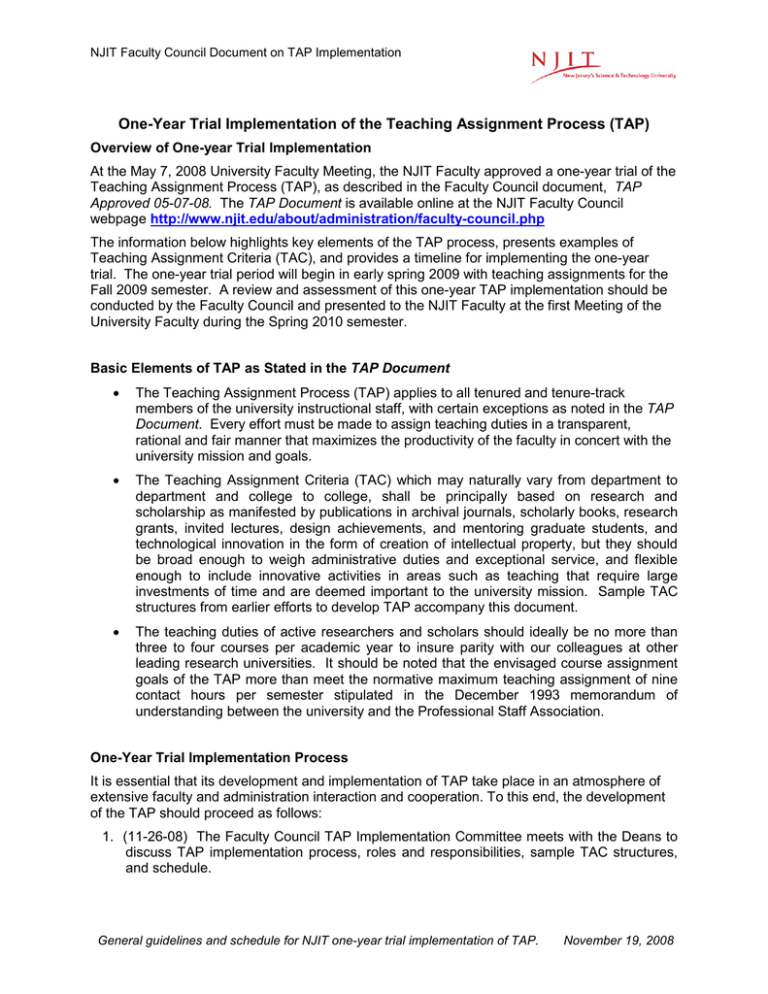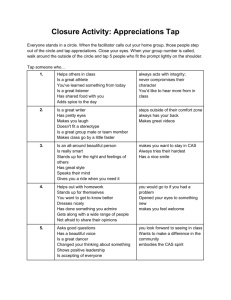One-Year Trial Implementation of the Teaching Assignment Process (TAP)
advertisement

NJIT Faculty Council Document on TAP Implementation One-Year Trial Implementation of the Teaching Assignment Process (TAP) Overview of One-year Trial Implementation At the May 7, 2008 University Faculty Meeting, the NJIT Faculty approved a one-year trial of the Teaching Assignment Process (TAP), as described in the Faculty Council document, TAP Approved 05-07-08. The TAP Document is available online at the NJIT Faculty Council webpage http://www.njit.edu/about/administration/faculty-council.php The information below highlights key elements of the TAP process, presents examples of Teaching Assignment Criteria (TAC), and provides a timeline for implementing the one-year trial. The one-year trial period will begin in early spring 2009 with teaching assignments for the Fall 2009 semester. A review and assessment of this one-year TAP implementation should be conducted by the Faculty Council and presented to the NJIT Faculty at the first Meeting of the University Faculty during the Spring 2010 semester. Basic Elements of TAP as Stated in the TAP Document • The Teaching Assignment Process (TAP) applies to all tenured and tenure-track members of the university instructional staff, with certain exceptions as noted in the TAP Document. Every effort must be made to assign teaching duties in a transparent, rational and fair manner that maximizes the productivity of the faculty in concert with the university mission and goals. • The Teaching Assignment Criteria (TAC) which may naturally vary from department to department and college to college, shall be principally based on research and scholarship as manifested by publications in archival journals, scholarly books, research grants, invited lectures, design achievements, and mentoring graduate students, and technological innovation in the form of creation of intellectual property, but they should be broad enough to weigh administrative duties and exceptional service, and flexible enough to include innovative activities in areas such as teaching that require large investments of time and are deemed important to the university mission. Sample TAC structures from earlier efforts to develop TAP accompany this document. • The teaching duties of active researchers and scholars should ideally be no more than three to four courses per academic year to insure parity with our colleagues at other leading research universities. It should be noted that the envisaged course assignment goals of the TAP more than meet the normative maximum teaching assignment of nine contact hours per semester stipulated in the December 1993 memorandum of understanding between the university and the Professional Staff Association. One-Year Trial Implementation Process It is essential that its development and implementation of TAP take place in an atmosphere of extensive faculty and administration interaction and cooperation. To this end, the development of the TAP should proceed as follows: 1. (11-26-08) The Faculty Council TAP Implementation Committee meets with the Deans to discuss TAP implementation process, roles and responsibilities, sample TAC structures, and schedule. General guidelines and schedule for NJIT one-year trial implementation of TAP. November 19, 2008 NJIT Faculty Council Document on TAP Implementation 2. (11-26-08) Each Faculty Council member informs their chair to form a departmental TAP Committee to begin the process and draft initial version of the TAC. Faculty Council Chair informs those departments that do not have a Faculty Council representative. 3. (12-12-08) Department TAP Committee meets with the Dean to discuss general structure of TAC and agree to basic guidelines, such as maximum and minimum teaching loads. 4. (01-23-08) Department TAP Committee develops draft TAC with input from department chair and other faculty, as appropriate. 5. (01-30-08) The TAC is approved by the department. 6. (02-13-09) Dean reviews the plans from all departments and recommends to the department any changes deemed necessary to achieve an appropriate level of uniformity across the college or school. 7. (02-20-09) Once all college/school TACs are approved by the Dean. The Deans meet with the Provost to assure that the TACs conform to the university mission and strategic plans, and also achieve a suitable degree of uniformity for the whole faculty. 8. (03-01-09) Each department uses the approved TAC to assign teaching loads to faculty for the Fall 2009 Semester. If the online Anticipated Professional Activities (APA) form is not operational, information needed for the TAC will be provided to the department chair by each individual faculty member. 9. If a faculty member disagrees with the teaching load assigned, the department P&T committee will decide if any changes in the assignment are justified. In the event that the situation is not resolved to the satisfaction of the faculty member at this stage, the options of appealing to Dean and then the Provost are still available. 10. (09-15-09) Each department should assess and modify, as needed, both the process and TAC so that the TAP can be used during the fall to set teaching loads for the Spring 2010 Semester. 11. (02-28-10) Faculty Council reviews TAP process and individual TACs to assess performance, extract “best practices”, and recommend future actions to the full faculty. General guidelines and schedule for NJIT one-year trial implementation of TAP. November 19, 2008





